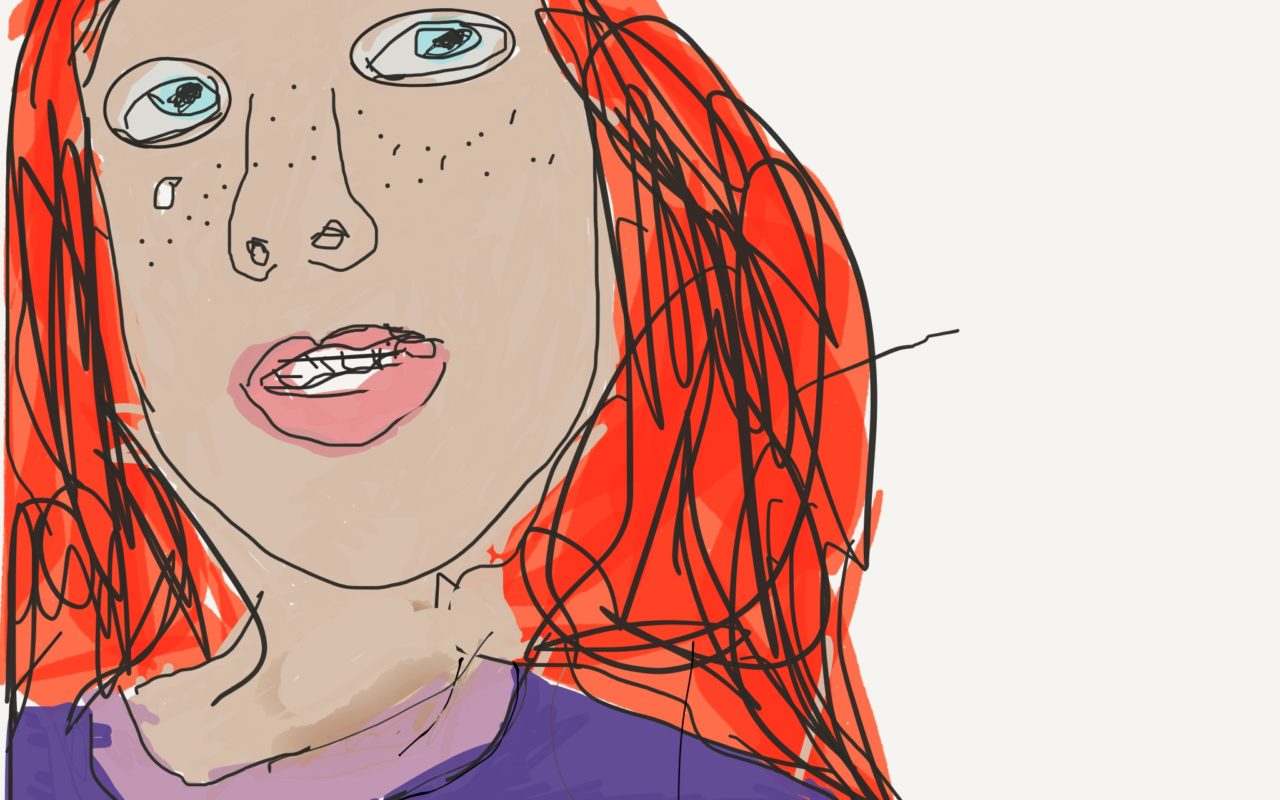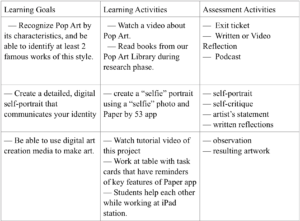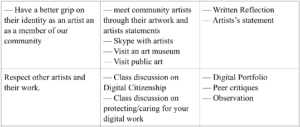
Andy Warhol and “Selfie” Portraits – My BHAG
As part of my coursework at Lamar, I have been reading “A Self-Directed Guide To Designing Courses for Significant Learning,” by L. Dee Fink, PhD. (2003). This guide is a great way to design a course or project holistically to ensure significant learning. I decided to include an example in a blog post so others might see how it works. The table is actually the resulting plan that comes from the guided process in the questions, below. I like this method of planning because of its use of backward design to create a lesson plan that integrates so many different learning goals that mesh together and reinforce one another.
BHAG (Big Hairy Audacious Goal) – Overarching Course Goal
Learners will create a detailed, digital self-portrait that communicates the students’ identity and personal artistic style, which will be presented along with an artists’ statement at the end-of-the-years art exhibit.
Students should:
1. Specific Context of the Teaching/Learning Situation:
20 kids, 5th grade, some very basic knowledge about human facial proportions (a few manga artists may have more info but it isn’t exactly correct). This is a live, in-class, elementary, related arts course that I try to integrate into the larger classroom learning scheme, in an inner-city school in a troubled neighborhood. Students have art for 30 minutes, once a week. We have a nice set of 20 iPads just for art, but they are shared among my almost 1000 students in 3 schools, so we have “sharing issues” sometimes (lost/deleted/destroyed work, someone messed with the settings, etc…) Most of my students struggle in school, but I have some amazing artists. My class offers free choice, so students can work their way through the unit in any order they like. There is limited space in my classroom, so it can get a bit frenetic.
2. General Context of the Learning Situation:
The school expects higher-quality, cookie-cutter, guided art projects. I sometimes hear complaints when students have free choice art because it does not make uniform displays for the bulletin boards, and kids tend to produce more “ugly art” when allowed to make mistakes. A lot of elementary art teachers in my profession choose Pinterest projects for this very reason. If you guide students step-by-step and everyone does the same thing, it’s hard to mess up, and looks impressive when displayed en masse. Society seems to expect this sort of thing, too, because it’s what we’re used to. I think there is a growing number of art teachers across the country who expect more authentic art learning, though.
3. Nature of the Subject:
Elementary art is a combination of theoretical and practical. It is traditionally taught in a convergent way, but art by nature should be divergent. More teachers are embracing the idea that art should come from the students’ own voice and choice, even at the elementary levels, though that is admittedly a tall order when kids get so little creating time.
4. Characteristics of the Learners:
They’re 5th graders, so still kids, but starting to hit adolescence. They have very limited exposure to art. We have a local museum, but it is too expensive for many of my students, many of whom don’t even have transportation to visit, (although there are increasing opportunities for such.) My students love learning digitally, but enjoy traditional art media, too. They are very young, so their goals are along the lines of “rap star, pro-athlete, pro-cheerleader,” but some are starting to consider college and more realistic career goals. Many of my students appreciate specific forms of art (street art, fashion design, architecture, etc…) they tend to find fine art a bit boring.
5. Characteristics of the Teacher:
I believe that students should learn in authentic ways, and create art in their own voice. Students have free choice of art materials, style, process, and should not be limited unless it’s absolutely necessary. I am a professional artist, as well as a teacher, so my knowledge and familiarity with art and art movements in the USA is pretty solid. I am passionate about making art as well as art history and art’s connection to other disciplines. My strengths in teaching are finding connections between art and other things (other subjects, student interests, community history…) and bringing out each student’s artistic voice.
Questions for Formulating Significant Learning Goals
“A year (or more) after this course is over, I want and hope that students will .”
… remember their connection to real artists through their experiences learning about art through their works. I also want students to feel pride for having created an amazing self-portrait that they feel really reflects who they are to the rest of the world. Lastly, I want them to be able to spot Pop Art and be able to identify it by its characteristics.
Foundational Knowledge:
I want students to know what a self-portrait is.
I want students to know what Pop Art is.
I want students to be able to identify 3 characteristics of Pop Art.
I want students to be able to identify at least 2 well-known artists of the Pop Art Movement.
Application Goals:
I want students to be able to take a photo with an iPad and load it into another app.
I want students to have a basic understanding of digital art making.
I want students to be able to create a digital self-portrait with details to express their identity.
I want students to be able to create responses (written, video, audio, infographic) to concepts
and ideas.
I want students to be able to deal with creative mistakes and find ways to work them out.
Integration Goals:
I want students to be able to reflect on their work and the work of other artists.
I want students to understand the connection between Pop Art and some favorite community
artworks.
Human Dimensions Goals:
I want students to feel a connection to other artists in the community through their self-portraits.
I want students to have a better grip on their own identity as an artist, and as a community
member.
I want students to look at ordinary people in a new way.
Caring Goals:
I want students to realize that artistic styles vary, and we don’t have to agree with other aritsts’
aesthetic choices to respect their work.
I want students to value their own face, talent, and story.
I want students to see art as an important part of their world.
I want students to value other people.
I want students to value their community.
“Learning-How-to-Learn” Goals
I want students to respect other students’ work.
I want students to practice good digital citizenship.
I want students to think ahead while they’re working, to be able to plan out their creative process.
I want students to learn time management.
I want students to be able to figure out an app by experimenting/playing with it.
Fink, L. D. (2013). Creating significant learning experiences: An integrated approach to designing college courses. John Wiley & Sons.


